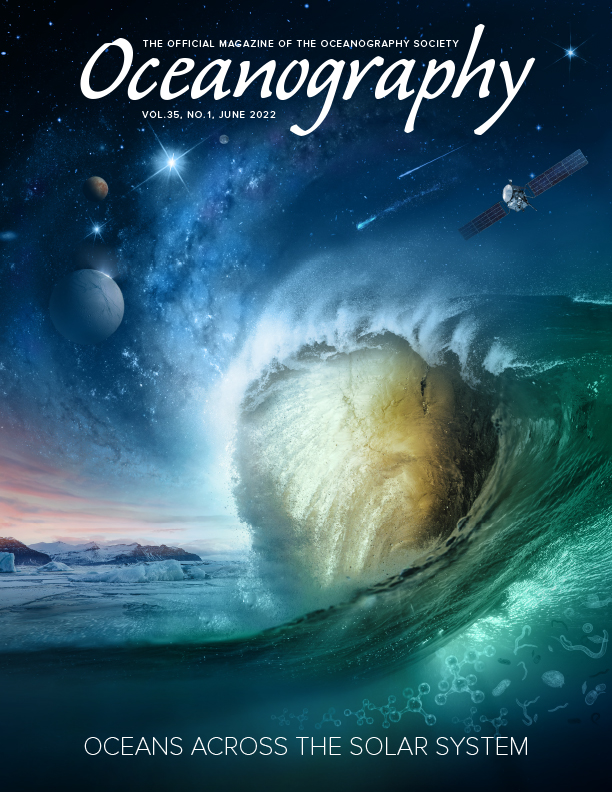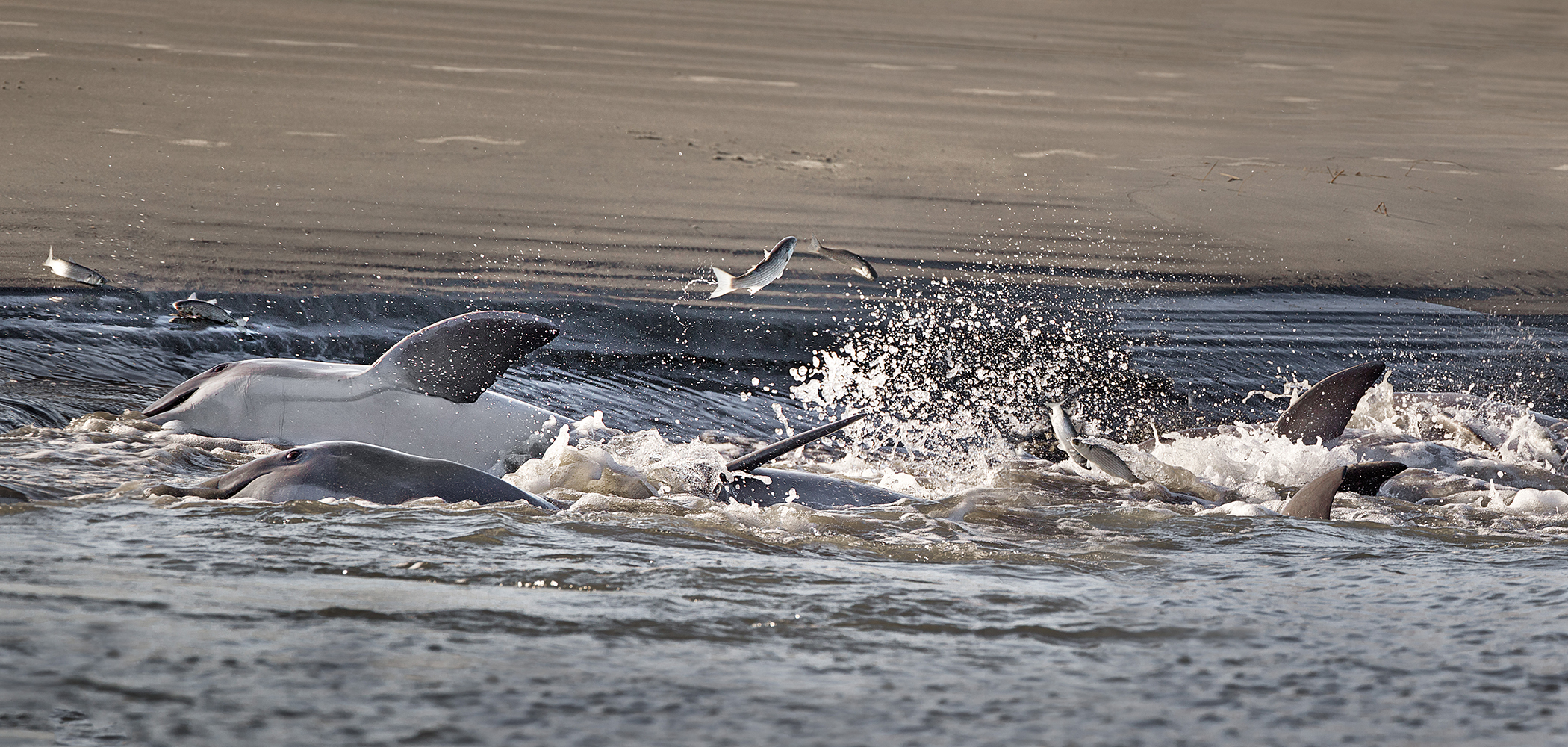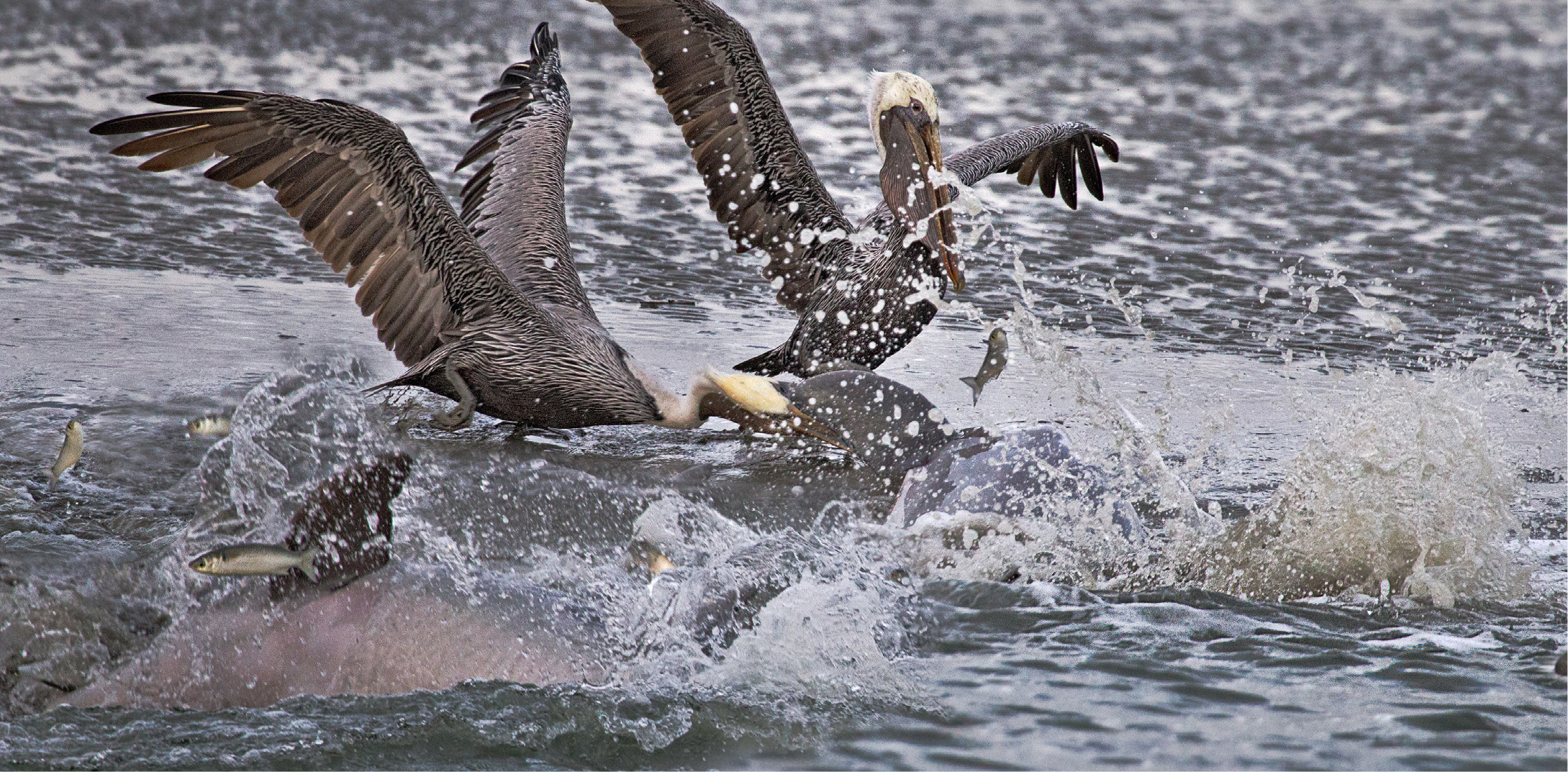Full Text
|
|
Captain Sam’s Spit, a sandy inlet at the southern end of South Carolina’s Kiawah Island, moves with the winds, the waves, the tides. Sand grain by sand grain, it erodes and accretes, erodes and accretes.
The spit’s shifting beaches and mudflats are important to species like piping plovers, diamondback terrapins, and Atlantic bottlenose dolphins. And to the dolphins’ prey, mullets. The fish leap out of the water in straight, clean slices to escape their predators.
Mullets aren’t the only animals jumping at Captain Sam’s Spit. The inlet is a showcase for a low-tide bottlenose dolphin behavior called strand feeding. It starts when two or more dolphins work together to herd a school of mullets into shallow water and toward the shoreline, in this case the muddy banks of the Kiawah River that runs between South Carolina’s Kiawah and Seabrook islands.
It’s early November when Captain Jake Feary, assistant director of outdoor programs at the Kiawah Island Golf Resort, ferries us in a Boston Whaler to a spot just off Captain Sam’s Spit. Slowing to an idle, we quietly bob in small waves, waiting for the display to start. Pelicans glide overhead, alerting us to fish below. Where pelicans go, so, too, go the dolphins.
Just off the starboard bow, water suddenly splashes in all directions. Fins appear, swirling in tighter and tighter circles. “The show is about to begin,” announces Feary. “The dolphins are herding the fish into a ball they can drive ashore, then they’ll surge onto the mudflat right behind them.”
Dolphins corral the fish in a circle of bubbles left in their wakes, pushing their prey ever closer to the shore’s edge. All at once, the dolphins rush the mudbank, forcing the flopping fish ahead of them. A wave of water from the lunging dolphins carries the fish forward.
The dolphins are right on their tails, heaving as much as two-thirds of their bodies onto the mudflat. Their prey is now stuck on the bank, unable to escape. When almost every fish has become the dolphins’ breakfast, lunch, or dinner, they shimmy back into the shallows, there to search for another school of fish to strand.
Only in the Lowcountry
Kiawah residents and visitors are lucky to witness the spectacle, Feary says. Dolphin strand feeding happens only in the Lowcountry and a very few other places around the globe. Captain Sam’s is the sole location where strand feeding doesn’t require a boat to spot. Depending on the time of day and therefore tide, people can watch by walking out to flats along the Kiawah River.
“Along the East Coast, strand feeding can be observed only in the tidal creeks and marshes of South Carolina and Georgia,” writes Cara Gubbins in The Dolphins of Hilton Head.
In South America, dolphins strand feed in Ecuador’s Gulf of Guayaquil. There, strand feeding occurs at very low tides in the interior channels of mangroves. Extreme low tides, such as those at the full moon, uncover wide mudflat beaches, creating good conditions for strand feeding, report Pedro Jimenez and Juan Jose Alava in the Latin American Journal of Aquatic Mammals.
“Groups of bottlenose dolphins, ranging from two to eight individuals, were observed first being very active and targeting fish in the middle of a channel and nearby mudflats and mangroves,” Jimenez and Alava write. “Then they started approaching and chasing their prey, trapping them against the mudbanks, onto which at least one or two dolphins stranded each time and captured the prey successfully.”
What, if any, signals the dolphins use to coordinate their bow wave is unknown. “No one has observed any definitive physical signal that always precedes strand feeding, nor has any acoustic signal (whistle or echolocation click) been reliably associated with strand feeding,” Gubbins states in The Dolphins of Hilton Head. “There might be a producer-scrounger effect: One dolphin initiates the rush, judging the correct time and place, and nearby dolphins, with their quick reflexes, simply follow the leader.”
Two dolphins strand feeding together can make a bigger wave as they rush the shore, beaching more fish.
At Captain Sam’s, the behavior happens every day. With bottlenose dolphins weighing almost 227 kilograms and mullet just centimeters long, the dolphins need to eat a lot of fish. That translates to hours of strand feeding.
“These dolphins are part of the Charleston estuarine population,” says Lauren Rust, executive director of the Lowcountry Marine Mammal Network. “They live in brackish waters year-round and spend a majority of their time in small areas—their home ranges.” That includes the Kiawah and Stono Rivers. The Stono flows southwest of Charleston, South Carolina, its channel running between the mainland and Wadmalaw Island and Johns Island.
“We’ve identified six or seven dolphins that strand feed pretty consistently in the Kiawah River,” says Rust. The dolphins usually feed in groups of three, “but I’ve seen up to five,” Rust recalls, “and sometimes a single animal. Sometimes they feed once or twice a day, other days up to 37 times.”
In the Charleston area, strand feeding happens year-round, but slows in winter when mullets go offshore.
The best time to see strand feeding at Captain Sam’s Spit, according to Feary, is the four-hour period around low tide. Then the Kiawah River’s main channel is at its most shallow and most narrow. The water level is below that of the marsh grasses, so mullets are more visible to the dolphins. They strand feed on both sides of the river, wherever there are mudbanks.
|
|
Meet the strand feeding dolphins
To learn more about the dolphins’ unusual feeding technique, the towns of Kiawah and Seabrook are supporting a bottlenose dolphin monitoring program coordinated by the Lowcountry Marine Mammal Network. Rust has recruited more than 20 volunteers to monitor each side of the Kiawah River at Captain Sam’s Spit every day during the summer months, and on weekends and holidays the rest of the year.
Data collected so far show that there are about 25 resident dolphins in the Kiawah River, with more than a dozen strand feeders.
Tagging and genetic studies have revealed information about the diet, age, sex, and health of the dolphins. Researchers are using photos of the dolphins’ dorsal fins, comparing each fin to those catalogued in a database, to track the cetaceans over time. “Identifying individuals allows us to learn about their home ranges, family units, new calves, and associations between individuals,” Rust says. “That information is important to understanding the health of the population and its habitat.”
One mother dolphin in the Kiawah River, KoKo, taught her calf, Kai, to strand feed. “On some days,” says Rust, “the pair spent more than 20% of its time in the inlet playing, feeding, and likely nursing.” Biologists have seen at least three mother-calf pairs frequenting the area, so it may be a safe place for mothers to bring their young.
A dolphin named Step “is one of the longest-studied near Charleston, having first been noted in 1995,” says Rust. “Since then, she has been spotted more than 70 times in the Stono River.” Low Country Marine Mammal Network staff members have also seen her in the Kiawah River, and have confirmed that she’s a strand feeder.
Researchers spotted her there with at least five calves. Two, named High Scoops and Rosie, are strand feeders themselves. The calves are 16 years old and 11 years old, respectively, and are independent from Step. But they’ve been glimpsed strand feeding together in a place where “they likely learned as young calves,” says Rust.
Step hasn’t been seen with a new calf in some time, indicating that her reproductive years may be complete.
Ever-inventive dolphins
“Bottlenose dolphins are noted for a diversity of foraging tactics that allow individuals to exploit a particular feature of their home range,” write biologists Teresa Gisburne and Richard O’Connor of the University of Massachusetts Dartmouth in the journal Marine Mammal Science. Those tactics extend well beyond strand feeding.
Kerplunking, as it’s known, is used in shallow seagrass beds such as those in Shark Bay, Australia. A dolphin lifts its flukes then drives them down into the water, making a splash and a “kerplunk” that startles fish out of hiding. Dolphins in Shark Bay may also wear cone-shaped sponges on their jaws while foraging in channels; the sponges offer the dolphins protection from abrasions when they’re fishing near coral reefs. In Calibogue Sound, South Carolina, dolphins feed on shrimp boats’ discarded bycatch, as well as fish disturbed by nets or attracted by boats, state Gisburne and O’Connor.
“Dolphins also use submerged structures, walls, even the seafloor to trap fish,” the biologists write.
The numerous feeding strategies of bottlenose dolphins are a credit to their adaptive nature, state Mystera Samuelson of the Institute for Marine Mammal Studies in Gulfport, Mississippi, and colleagues in a recent paper in Animal Behavior and Cognition. Samuelson studied the dolphins of Biloxi Marsh southeast of New Orleans in St. Bernard Parish, Louisiana. Marshes “are notably different than other dolphin habitats due to their shallow, turbid waters, muddy substrates, and outcroppings of cordgrass (Spartina spp.), creating steep embankments along meandering channels,” write Samuelson and colleagues.
Biloxi Marsh dolphins feast on spotted sea trout, mullet, croaker, red drum, and menhaden. How they do it is what surprised the researchers. The dolphins have a unique solitary feeding style called marsh bank feeding.
A dolphin swims slowly parallel to and less than one body length from a marsh bank, identifies a target prey fish, and…the chase is on. The dolphin then drives its quarry—a single large fish rather than a school of fish—toward the bank, where it attempts to capture the prey. If the dolphin is successful, the fish is trapped against the bank. If the fish gets away, the dolphin patrols for the next hapless fish.
In Biloxi Marsh, the scientists report, only occasionally does a dolphin strand on a marsh bank, “a coincidental result of a spirited fish chase.”
|
|
Looking down the strand
Watching dolphins engaged in behaviors such as marsh bank or strand feeding “can be exhilarating,” says Rust, “but we all must proceed with care.” Research shows that dolphins change their behavior as a result of human interference. “That would be a huge loss to both the dolphins and to us,” Rust believes. “On a summer day, the presence of hundreds of onlookers can increase stress on the dolphins and lead to a change in behavior, illness, or reproductive failure.”
Under the US Marine Mammal Protection Act, it’s illegal to touch, feed, swim with, or harass dolphins, with fines of up to $100,000. Harassment is defined as any human disturbance that alters a dolphin’s behavior (such as the dolphin ceasing to feed, chuffing, slapping its tail, or leaving an area).
The bottlenose dolphin is the most common marine mammal in the Charleston region. As a long-lived animal important in the marine food web, the dolphin is a sentinel species that reflects such parameters as water quality and the health of fish stocks—information that’s critical to the entire ecosystem, including us.
“Racing alongside a boat or leaping in front of the setting sun, dolphins have been capturing human hearts for centuries,” writes Gubbins. Now we need to do our part, says Rust, to be sure that endures for many more.




